Research Article :
Renu Nayar and Rajani Patel Ground
water in general is clean and fresh. However, industrialization and
urbanization together with intensified agricultural activity have led to
increasing demands on one hand but to the potential for large scale release of
contaminants on the other. Water pollution disturbs the normal uses of water
for agriculture, public water supply, aquatic life, wild life and industry. An
understanding of the various types of pollutants is of considerable importance
to the efficient management of water resources. Inorganic pollutants discharged
into natural waters consist of mineral acids, inorganic salts, metal compounds,
complexes of metal and trace elements. The proposed investigation will evaluate
the underground water quality of hand pump water and Tap water of Sirgitti in
rural area and its surrounding industrial areas near 7 km from Bilaspur C.G. With
this objective in mind, A new and low-cost technology for purification for
water by water hyacinth (Eichhornia
crassipes), is a feasible solution. Water samples were collected during
the growth of water hyacinth. Water purification with low-cost treatment
technology using water hyacinth. The common
Water Hyacinth is vigorous growers known to double its population in only 12 to
15 days. In the Water Hyacinth area and the nearby area, water pH showed a
decrease between the August and September sampling followed by an upward trend
and stayed stable around 9.3 in the far water hyacinth area. Water transparency
showed a slow increase in August and September, and then a gradual decline in
October; generally, transparency was significantly lower in the water hyacinth
area than in other areas. Water Hyacinth has been used in aquatic systems
worldwide for waste water purification. It has tremendous capacity of absorbing
nutrients and other substances from the water and hence brings the pollution
load down. In the present study an attempt was made to find the potential of
Water Hyacinth in the treatment of Tap and hand pump water near industrial area
of Sirgitti. The parameters studied were pH, EC, DO, BOD, TDS, Salinity,
Alkalinity and Turbidity. Six months of experimental investigation showed that
water hyacinth reduced considerably all the physicochemical parameters and but
increased the Dissolved Oxygen (DO) to a significant level therefore it is
concluded that Water Hyacinth (Eichhornia
crassipes) is highly efficient in purification of water in respect of
physicochemical parameters. Water is essential for everything on
our planet to grow and prosper. Water that is free of disease-producing
micro-organisms and chemical substances deleterious to health is called potable
water. Water contaminated with either domestic or industrial wastes is called
non potable or polluted water. The objectives of primary concern in providing
potable water are freedom from harmful m micro-organisms and freedom from
undesirable or harmful chemicals. Although we as humans recognize this fact, we
disregard it by polluting our rivers, lakes and oceans. Despite advances in
drilling, irrigation and purification, the location, quality, quantity
ownership and control of potable water remains an important human concern [1].
Water is said to be polluted when it is changed in its quality or composition
directly or indirectly as a result of waste disposal and other human activities
so that it becomes less suitable or harmful for drinking, domestic,
agricultural, fisheries
or other purposes. Temperature, turbidity and total suspended solids in underground
water can be greatly affected by human activities such as agriculture,
deforestation and the use of water for cooling. For example, the upward trend in
soil erosion and the related increase in total suspended solids in rivers can
be seen in most of the mountainous regions in India. The release of untreated
domestic or industrial wastes high in organic matter into rivers results in a
marked decline in oxygen concentration and a rise in ammonia and nitrogen
concentrations, downstream of the effluent input. Industrial activities which
discharge large organic loads include, pulp and paper production and food
processing. Uncontrollable discharge of industrial waste water often causes
pollution due to toxic metals [2]. Other sources of metal pollution are
leachates from urban solid waste landfills and mining waste dumps. Increased
mineral salts in rivers may arise from pollution by mining and industrial waste
waters. Under certain hydrogeological conditions, unsewered domestic waste can
cause severe ground water contamination by pathogenic bacteria, nitrate and
other pollutants. Pumping of industrial waste water into ground water has
resulted in high nitrate, arsenic and iron content [3]. All-natural waters
contain dissolved inorganic and organic substances. In natural surface water,
the major dissolved solids are calcium, magnesium, sodium, potassium sulphates,
carbonates, bicarbonates, chloride and silica. Many pollutants may also be
found in solution form in water. These may be phosphates, fluorides, nitrates
and certain metals or may be unnatural materials such as pesticides [4]. Many
causes of pollution including sewage and fertilizers contain nutrients such as
nitrates and phosphates. In excess levels, nutrients over stimulate the growth
of aquatic plants and algae. Excessive growth of these types of organisms
consequently clogs our water ways, use up dissolved oxygen as they decompose,
and block light to deeper waters. This in turn proves very harmful to aquatic
organisms as it affects the respiration ability of fish and other invertebrates
that reside in water. Pollution is also caused when slit
and other suspended solids, such as soil, wash off plowed fields, construction
and logging sites. Pollution in the form of organic material enters waterways
in many different forms as sewage, as leaves or as runoff from live-stock
feedlots and pastures. Pathogens including bacteria, viruses and protozoan
enter waterways through untreated sewage, storm, drains and septic tanks [5].
Heat is a pollutant because increase in temperature results in death of many
aquatic organisms. Heated waters reduce the amount of dissolved oxygen content
which degrades organic matter at a faster rate. Thus, we can conclude that
there exist two types of water pollutants: point source and non-point source. Point sources of pollution occur
when harmful substances are emitted directly into a body of water. A non-point
source delivers pollutants indirectly through environmental changes [6]. Water
hyacinth is a permanent, marine plant, free floating perennial herb for fresh
water ecosystem or anchor in low water. It is frequently appeared at the
surface of rivers, lakes, canals and ponds and may root in the mud of shallow
waters. It is a noxious weed that has attracted worldwide attention due to its
fast spread and growth, which lead to serious problems in navigation,
irrigation, and power generation. Water Hyacinth which is native to the Amazon
basin, Brazil became widespread throughout the world, also due to its
attractive appearance. It is commercially available as an ornamental for ponds.
Its spread
started with its deliberate introduction into North America from Brazil, in the
late nineteenth century, as an ornamental in ponds and subsequently escaped
cultivation. At present it occurs as a weed throughout tropical and subtropical
regions of the world. Water hyacinth is free floating aquatic plants in which
roots play important role in removing nutrients (Reed Crites and Middle Brooks,
1995). It has tremendous capacity of absorbing nutrients and other substance
from water [7] and hence brings the pollution load down. It is found to be most
effective in removal of BOD, suspended solids, and heavy metals etc. from waste
water [8]. The plant is extremely tolerant and has a high capacity for the
uptake of heavy metals, including Cd, Cr, Co, Ni, Pb and Hg, which could make
it suitable for the bio-cleaning of industrial wastewater. In addition to heavy
metals, Water hyacinth can also remove other toxins, such as cyanide. It can
remove arsenic from arsenic contaminated drinking water. It may be a useful
tool for removal of toxic metals as it can soak up soluble heavy metal ions. Figure 1: Root of water hyacinth plant. Ground water is the major source of
drinking water in both urban and rural India. Besides, it is an important
source of water for the agricultural and the industrial sector. Being an
important and integral part of the hydrological cycle, its availability depends
on the rainfall and recharge conditions. India is heading towards a fresh water
crisis mainly due to improper management of water resources and environmental
degradation, which has led to lack of access to safe water supply to
millions of people. Ground water crisis is not the result of natural factors;
it has been caused by human actions. During the past two decades, the water
level in several parts of the country has been falling rapidly due to increase
in extraction. Intense competition among user’s agriculture, industry and
domestic sectors is driving the ground water table lower. The quality of ground water is
getting severely affected because of the widespread pollution of surface water.
Besides, discharge of untreated waste water through bores and leachate from
unscientific disposal of solid wastes also contaminates ground water.
Physico-chemical analysis is the prime consideration to assess the quality of
water for its best usage, say for drinking, bathing, fishing, industrial
processing, etc. It is also essential to know the pollution strength of waste
water either domestic or industrial. Although a large number of studies have
been done on using the stems and leaves of water hyacinth as absorbent, there
are several interesting and novel applications of water hyacinth. For example,
water hyacinth has been demonstrated to be useful to develop super capacitors,
for production of ethanol, and to improve the immune resistance of plants and
animals [9]. The experiment was performed in the
Department of Chemistry, D. P. Vipra College, Bilaspur, in Chhattisgarh in
India. Water Hyacinth was taken from Arpa river in Bilaspur washed thoroughly
in running tap water to avoid any surface contamination, blotted with clean
blotting paper for any surface moisture avoiding damage to root and leaf. During
investigation we have taken three big jars for experimental work. ·
Sample no 1-100% Tap water ·
Sample no 2-100% hand pump water near industry ·
Sample no 3-Tap water and water hyacinth plants The Laboratory Test Parameters The laboratory test parameters were
chosen Temperature pH, Electrical conductivity (EC), Total Solids Total
Dissolved solids (TDS), Salinity, Alkalinity, Turbidity, Biochemical Oxygen
Demand (BOD) and Dissolved Oxygen (DO). Methodology of the Treatment of Water Sample Different parameters of water
samples were measured separately Temperature pH, Electrical conductivity (EC)
and Total dissolved solids (TDS) of the sample by digital potable instrument
and Turbidity was measured by Nephelometric turbidity meter on the laboratory.
Analysis of Salinity, Alkalinity, Dissolve Oxygen (DO), Biological Oxygen
Demand (BOD), were done according to standard methods by Trivedi and Goel (1984),
APHA (1985) and APHA (1999) [10-11]. Sample Preparation for Removal of Heavy Metals Fresh samples were chopped to 3.0 cm
in length and mixed uniformly. Mixed samples were subjected to hot air oven for
estimation of dry matter. The remaining samples were sun dried for about 7 days
at an environmental temperature of 22.8-33.8°C and relatively high humidity.
Approximately 500g of dried, uniformly ground samples were collected for
proximate ana. Figure 2: Fresh, Dry and Chopped Sample of Water Hyacinth. Study of Growth Rate and Physico-Chemical Analysis by Water
Hyacinth Water Hyacinth is aquatic vascular
plant with rounded, upright and shiny green leaves and lavender flowers. It is
fast growing perennial with great reproduction potential. Growth of Water
Hyacinth is primary dependent on ability of plant to use solar energy, nutrient
composition of water, cultural methods and environmental factors. The effect of
Water Hyacinth has resulted in significant decrease in turbidity and due to
which the removal of flocs and reduction in organic matters in water have been
observed. The primary purpose of this study is to make use of the water
hyacinth plant for the purification of the tap water and hand pump water. The
common water Hyacinth (Eichhorniacrassipes)
is vigorous growers known to double its population in only 12 to 15 days.
Optimal water pH for growth of this aquatic plant is neutral but it can
tolerate pH values from 5 to 10. This is very important fact because it points
that water hyacinth can be used for treatment of three types of contaminated
water. Figure 3: Water hyacinth growth is on 1st day. Figure 4: Water hyacinth growth is double after 12 days. In the present work, optimal water
temperature for growth recorded 28-30oC. But temperatures above 33oC
it’s inhibited further growth. Water Hyacinth is growing fastest at
temperatures from 200C to 300C, but growth fully stops at
temperatures from 80C-150C and above 350C. To
understand the growing ability of Water Hyacinth, its growth rate was studied. Above
Figure 3 and Figure 4 shows a Water Hyacinth plant which was taken and allowed
to grow in a bucket of capacity 16 lit. With tap water in Sirgitti Area. Figure 5: The Growing ability of Water Hyacinth Plant. Weight of this Water Hyacinth plant
was taken weekly in a digital weighing machine (Least count of 1.9g) for seven
consecutive weeks and a weight Vs time graph was obtained. The result showed
the growth rate of water hyacinth was 60gm. /week. Per week Growth rate of
water hyacinth especially in the seventh week the growth of Water Hyacinth was
more due to the growth of new leaves and development in its root system. From
the graph obtained in figure 5 it can be concluded that Water Hyacinth can
double its population in less than two weeks, with an average local temperature
of 240C to 340C. This study focused on temperature,
EC Dissolved Oxygen, BOD, turbidity because these water quality parameters have
been shown to be important drivers in the growth and distribution of various
fish species. Water Hyacinth was cultured in the tank of approximately 6ft X
4ft X 3.0 ft. dimension. The parameters studied were pH, EC, DO, BOD, TDS,
Salinity, Alkalinity and Turbidity in the separate jars. Six months of
experimental investigation showed that Water Hyacinth reduced considerably all
the physico-chemical
parameters and increased the Dissolved Oxygen (DO) to a significant level
therefore it is concluded that Water Hyacinth is highly efficient in
purification of polluted tap water as well as hand pump water in respect of
physicochemical parameters. In the present study showed that it was made to
find the potential of Water Hyacinth in the treatment of polluted tap water in
industrial Areas. Figure 6: measurement of pH with pH digital potable meter. An experimental studied,
Evapotranspiration of Water Hyacinth in Two jars of 10 litres capacity each one
with Water Hyacinth and another without Water Hyacinth were taken and filled
with equal volume of water 10 litres. After 48 hours (2 days) the depleted water
levels were measured in both the jars. The difference between the readings of
the jar will give the transpiration rate of water hyacinth whereas the reading
of the jar in which the water hyacinth was kept will give the
Evapotranspiration. It was also observed that there was just a little
difference between the pH of the water that is underneath the mats of E.crassipes and that of the water that
is free from E.crassipes mats. The concentration of the Dissolved
Oxygen (DO) in the water is above the minimum limit of 5.0mg/l in fresh water
that is necessary for the survival of aquatic fauna. The values of BOD,
however, showed great variation among the samples. Whereas sample 2 (100% hand
pump water near industrial area) had the highest BOD concentrations of
22.4mg/l, sample 1 (100% tap water) had the lowest 12.0mg/l., since the
percentage total organic matter (%TOM) in the plants are high (about
90.8mg/100g) and thus, requires higher amounts of dissolved oxygen to
decompose. The salinity of water 7.25mg/l was low enough to favour the
proliferation of E.crassipes. The
salinity as well as the alkalinity showed very minimum variation among the
samples 2 and 3 as compared to sample 1. The experimental study showed that
TDS, EC and pH value after purification decreased significantly in all the
three water samples. For sample no 3, we got to see very good results obtained
and it was showed maximum reduction of pH TDS, and EC by water hyacinth. The pH
and EC reduction by water hyacinth plant was maximum in sample no 2 (In hand
pump water). pH from 8.78 to 7.43 in sample no 2 and from 7.92 to 7.44 in
sample no 1. While EC decreases from 1218 moh cm-1 to 943 moh cm-1
in sample no 2 and 1046 moh cm-1 to 441 moh cm-1 in
sample no 3. This reduction in pH is due to absorption of pollutants by root of
water hyacinth plant and EC due to consumption of ions by Water Hyacinth plant.
During the study DO value increased
in all the samples in the experimental year August 2019 to January 2020. The
maximum value DO was found to be 8.6mg/l at S-2 and 9.2 in sample no 3 due to
Photosynthesis helps in maintaining the oxygen supply for plants while
respiration helps in maintaining dissolved oxygen content in the water. The DO
increase in sample no 1 was minimum where it increases from 4.68 mgL-1 to 6.40
mgL-1. The photosynthetic
activities in plants increase the DO in water, thus creating aerobic
conditions in the system. Similar findings had also been reported by other
author [12-13]. BOD is the amount of oxygen that will be consumed by
microorganism during the biological reaction of oxygen with organic material
and. The BOD reduction by test plant (Eichhornia
crassipes) was maximum in sample no 3 where it decreases from 39.8 mgL-1 to
18.3 mgL-1 and from 44.6 mgL-1 to 22.8 mgL-1 in sample no 2. The turbidity
reduction by Water Hyacinth plant (Eichhornia
crassipes) was maximum in sample no 2 and minimum in sample no 1 where it
decreases from 5.26 NTU to 2.36 NTU. This reduction in turbidity is due to the
root hairs as they have electrical charges of colloidal particles such as
suspended solids and cause them to adhere on the roots where they are slowly
digested and assimilated by the plant and microorganism [14-16]. Figure 7: Measurement of electrically conductivity by digital conductometer. The root system provides an enormous
surface area that absorbs and accumulates the water and nutrients essential for
growth, as well as other non-essential contaminants. The present study clearly
indicated that the underground water samples studied were generally safe for
drinking purposes. However, there were specific instances of chemical pollution
in some samples. Water from these hand pumps are frequently used by population
in vicinity of these hand pumps for their domestic purposes. Some of the
physical-chemical parameters have either crossed the threshold limit or are
near it for certain samples. WHO has recommended 6.0 mg/l as the maximum
permissible value for biological oxygen demand, but the BOD
values found never exceeded this limit at all the sampling stations indicating
no biological pollution load on these water bodies. During the study period,
the value of Dissolved Oxygen observed were many times higher than the maximum
permissible limit of 5 mg/l prescribed by WHO at all the sampling stations. Oxygen
transfer by aquatic plants in to the root areas plays an important role in the
growth of aerobic bacteria and subsequent degradation of waste water. Moreover,
the higher suspended solids in the effluent samples help in enhanced microbial
activity as additional substrate on the roots of aquatic plants.
Organic pollutants enter the water
system due to domestic and animal sewage, industrial waste from food processing
plants and paper mills, run off from agriculture lands etc. Decrease in
dissolved oxygen is an indication of water pollution due to organic pollutants.
In view of these findings, it is suggested that regular monitoring of the
physico-chemical parameters is required at strategically selected sampling
sites, otherwise these areas will become more and more prone to water related
hazards and the ultimate sufferers will be the people residing in the nearby
areas. Therefore, it is concluded that Eichhornia
crassipes is highly efficient in purification of polluted water in respect
of physicochemical parameters. 1. Cunningham WP and Saigo WB. Environment Science (3rd Edn) (1995) WC Brown Publishers, United Kingdom 286-287. 2. Trivedi SE and Goel PK. Chemical and Biological Methods for water pollution studies (1984) Env Pub Karad, India. 3. Khan AN. Tackling Water Pollution Govt of India Publication. 4. Venkataeswarlu KS. Water Chemistry (1st Edn) (1999) New Age International Publishers, India 2-4. 5. Purohit SS. Microbiology Fundamentals and Applications (2002) Agrobios Publishers, India 439-443. 6. Krantz D and Kifferstein B. Water Pollution and Society 1-11. 7. Boyed CE. Vascular aquatic plants for mineral nutrient removal from polluted waters (1970) Economic Botany 24: 95-103. https://doi.org/10.1007/bf02860642 8. Gupta GC. Use of water hyacinth in wastewater treatment (1982) J Envi Health 43: 80-82. 9. Villamagna AM. Ecological effects of water hyacinth (Eichhornia crassipes) on Lake Chapala, Mexico (2009) Virginia Polytechnic Institute and State University, Blacksburg, Virginia, USA. 10. Trivedi SE and Goel PK. Chemical and Biological Methods for water pollution studies (1984) Envi Pub Karad, India. 11. American Public Health Association (APHA) (1985) Standard methods of water and wastewater analysis, American Public Health Association, United States. 12. Basker G, Deeptha VT and Rahman AA. Treatment of wastewater from kitchen in an institution hostel mess using constructed wetland (2009) Int J Recent Trends in eng 1. 13. Yadav SB, Jadhav AS, Chonde SG and Raut PD. Performance evaluation of surface flow constructed wetland system by using Eichhornia crassipes for wastewater treatment in an institutional complex (2011) Universal J Envi Res and Techn 1: 435-441. 14. Dipu S, Anju A, Kumar V and Salom GT. Phytoremediation of dairy effluent by constructed wetland technology using wetland macrophytes (2010). Global J Envi Res 4: 90-100. https://doi.org/10.1007/s10669-011-9331-z 15. Neralla S, Weaver RW, Varvel TW and Lesikar BJ. Phytoremediation and on-site treatment of septic effluents in sub-surface flow constructed wetlands (2007) Envi Techn 20: 1139-1146. https://doi.org/10.1080/09593332008616911 16. Shah RA, Kumawat DM, Singh N and Wani KA. Water hyacinth (Eichhornia crassipes) as a remediation tool for dye-effluent pollution (2010) JSN 1: 172-178. Renu
Nayar, Department of Chemistry, DP Vipra College Bilaspur CG, India, E-mail: nayar.renu@yahoo.co.in Nayar R and Patel R. Rural water quality monitoring
and exploring low-cost treatment technology with water hyacinth (2021) Edelweiss
Appli Sci Tech 5: 9-13. Ground water, Industrialization and
urbanization, Water pollution and Water hyacinth.Rural Water Quality Monitoring and Exploring Low-Cost Treatment Technology with Water Hyacinth
Abstract
Full-Text
Introduction
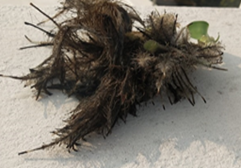
Methods and Materials
Experimental Plan

Result and Discussion
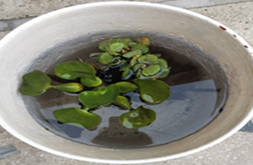
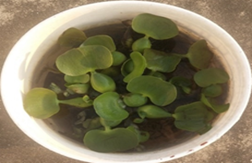

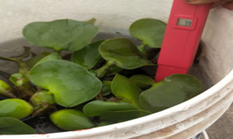
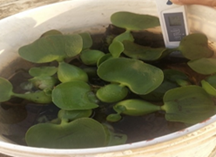
Conclusion
References
Corresponding author
Citation
Keywords